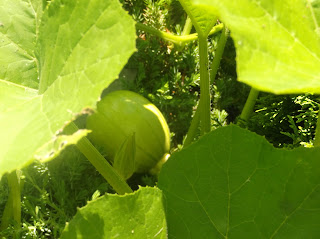Growing pumpkins has been a long dream. Last year the attempt was a nightmare. No bees were coming to the flowers to pollinate, the pumpkins did not get enough water due to some very bad advice, little fungicide and insecticide were used due to bad advice, and every pumpkin that started to develop quickly shriveled up and died. Yeah, it was a bad pumpkin patch. So what to do when a pumpkin patch goes wrong? Try again.
This year, I moved it closer to some bushes with an abundance of bees, planted them in April and so far, so good. 10 pumpkins are already on the scene, minimal damage with the help of some fungicide, and things seem to be going well. A few hints to growing a good pumpkin patch, learned from last years failure:
- Plant a little early (depending on the area lived)-however, be careful of frost, always cover the sprouts before dawn if there is any chance of frost. Old bed sheets held down with big rocks, brick, or concrete work perfectly, but remember to take the sheets off after the threat of frost is over the next day.
- Talk to local planters-locals who grow these things know best. Some say to not plant early, but many say to plant early. They are also the people to talk to about the use of fungicide and insecticide (it does not take much of either).
- Water the pumpkins when needed (not after 7+ straight days of rain but at least every other day, every morning if the ground is very dry).
- Water in the morning-that way the sun dries off the leaves throughout the day.
- Use plant food. Pour some vegetable food (mixed as directed) recommended by local gardeners or after thorough research, onto the roots of the plants every 7 days.
- Pick off the bugs. Instead of constantly spraying down with insecticide, walk through the patch at least 2 times a day and pick off any bugs eating the leaves. If needed spray with insecticide, but follow the directions to the tee. Use as directed.










No comments:
Post a Comment